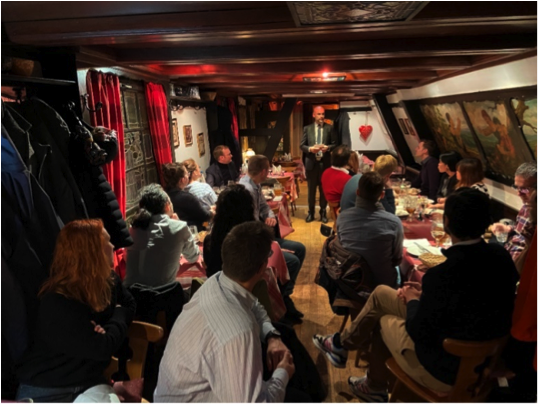Digital transformation is reshaping the aeronautic industry: MIPLM Dinner speech from head of IP MTU aero engines
Customer demands and digitalization will transform aerospace over the next decade. With a dinner speech from Mr. Christian Grünberger, head of IP management, the participants of MIPLM made a deep dive within the digital transformation of this fascinating industry. When it comes to technological and business disruption, the aerospace industry has had it comparatively easy over the past couple of decades. Aircrafts got bigger and then smaller and always more efficient, but the way planes flew and the way they were manufactured remained essentially the same.
With close to 6 billion annual passengers expected by 2030, up from 3.7 billion today, the aeronautical industry is at a crossroads. It faces multiple challenges, such as limiting its environmental impact and energy costs, increased safety requirements for both passengers and crew members, and the entrance of new competitors into the market who are redefining the established business models, such as low-cost carriers and aircraft leasing companies.
 The economic climate confronting aerospace manufacturers was nothing like the commotion that had rocked airlines since the beginning of the millennium, after a swarm of online travel agencies and price-comparison websites brought pricing transparency to the sector. That upheaval, against the backdrop of the global financial meltdown, chipped away at carrier margins and customer relationships and unleashed a competitive onslaught that forced consolidation. It even took down some well-known players. For aerospace, that period of relative calm is about to end as new technology and customer demands begin to reshape the industry’s business model over the next decade. As this wave of mega-disruption sweeps the sector, aerospace manufacturers should learn a key lesson from the airlines: Incumbents must quickly embrace the big, bold ideas disruption brings — or else prepare to face off against faster-moving players.
The economic climate confronting aerospace manufacturers was nothing like the commotion that had rocked airlines since the beginning of the millennium, after a swarm of online travel agencies and price-comparison websites brought pricing transparency to the sector. That upheaval, against the backdrop of the global financial meltdown, chipped away at carrier margins and customer relationships and unleashed a competitive onslaught that forced consolidation. It even took down some well-known players. For aerospace, that period of relative calm is about to end as new technology and customer demands begin to reshape the industry’s business model over the next decade. As this wave of mega-disruption sweeps the sector, aerospace manufacturers should learn a key lesson from the airlines: Incumbents must quickly embrace the big, bold ideas disruption brings — or else prepare to face off against faster-moving players.
The rapid expansion of air transport presents a challenge for the aeronautical industry in terms of productivity. Estimates from Flight Fleet Forecast 2016-2035 suggest the size of the global commercial fleet could reach almost 50,000 aircraft by 2035, compared to 19,500 today. While aircraft order backlogs now represent 8 years of production, growing demand is placing intense pressure on all players in the industry. Meeting this challenge will therefore require an increased emphasis on R&D and innovation.
Thanks to the digital revolution, engineering solutions known as “Factory 4.0” can increase productivity along the production line. For example, 3D printing manufactures complex parts through precise processes to reduce production time. This represents considerable savings in terms of time and material waste.
The overall improvement in production efficiency also requires optimizing inventory management and supply chain management – all the way from the subcontractors to the airlines. Deploying B2B e-commerce technologies streamlines both inventory and supply chain flow, which saves time and resources.
The world is talking about Industry 4.0 or the fourth industrial revolution, that is, the current trend of higher level of automation, digitalization and data exchange in manufacturing technologies. It includes cyber-physical systems, Internet of Things and cloud computing among other technological assets. With more than 5000 sensors, which generate up to 10 GB of data per second, modern aircraft engines are an exponent of what digitalization and the Internet of Aircraft Things could furnish, as part of the upcoming Industry 4.0 revolution, in the aviation industry. This new era has the potential to improve air transport key performance areas. Particularly, in an industry where safety levels are so high and the margins for improvement are extremely tight, this upcoming era might imply a shift in safety improvement.
In the movie, you can see Siemens vision about the future of aerospace:
MTU Aero Engines is Germany’s leading engine manufacturer and an established global player in the industry. The company engages in the design, development, manufacturing, marketing and support of commercial and military aircraft engines in all thrust and power categories and stationary gas turbines. Operating affiliates all over the world, MTU has a local presence in major regions and markets.
In the commercial engine business, MTU has content from propulsion systems for business jets and engines for narrow-body aircraft with geared turbofan technology to the world’s most powerful engines. The company is a valued and trusted partner to all big players in the industry: GE, Pratt & Whitney and Rolls-Royce.
In the maintenance business, MTU Maintenance is the world’s largest independent provider of commercial engine MRO (maintenance, repair and overhaul) services in terms of sales. The primary focus is on providing support for engines in which MTU is a risk- and revenue-sharing partner. MTU is the leading global provider of maintenance and repair services for the V2500, the engine powering the current Airbus A320 family of aircraft. MTU Maintenance also offers repair solutions for a wide variety of different engine types. In the military arena, MTU Aero Engines is Germany’s industrial lead company for practically all engines flown by the country’s military. The company delivers the enabling technologies, develops and manufactures engines and engine components, and provides logistics support.
 Mr. Christian Grünberger is director intellectual property management since 2008 at MTU aero engines. He spoke about the new role of IP departments and what IP experts can do to foster innovation within their organizations: “The innovation driven IP department”.
Mr. Christian Grünberger is director intellectual property management since 2008 at MTU aero engines. He spoke about the new role of IP departments and what IP experts can do to foster innovation within their organizations: “The innovation driven IP department”.



